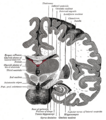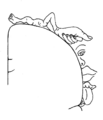Somatosensory system facts for kids

The 'somatosensory system' is a sensory system that detects experiences labelled as touch or pressure, temperature (warm or cold), pain (including itch and tickle) and those that belong to proprioception. These are the sensations of muscle movement and joint position including posture, movement, visceral (internal) senses and facial expression. Visceral senses have to do with sensory information from within the body, such as stomach aches.
Touch may be considered one of five human senses; however, when a person touches something or somebody this gives rise to various feelings: the perception of pressure (shape, softness, texture, vibration, etc.), relative temperature and sometimes pain. Thus the term "touch" is actually the combined term for several senses. In medicine, the colloquial term "touch" is usually replaced with somatic senses, to better reflect the variety of mechanisms involved.
Other pages
Images for kids
-
The cortical homunculus, a map of somatosensory areas of the brain, was devised by Wilder Penfield.
See also
 In Spanish: Sistema somatosensorial para niños
In Spanish: Sistema somatosensorial para niños





